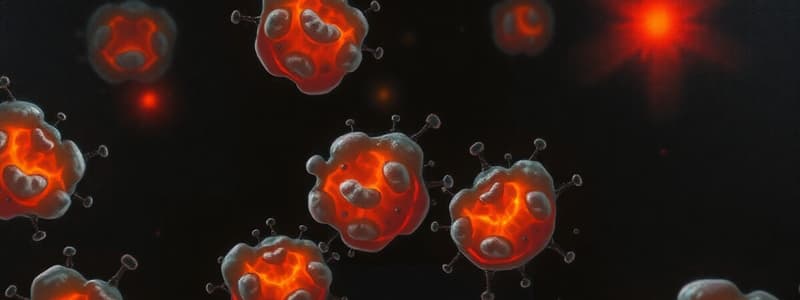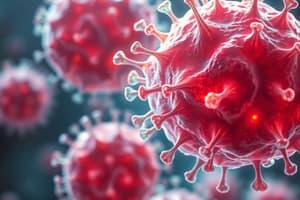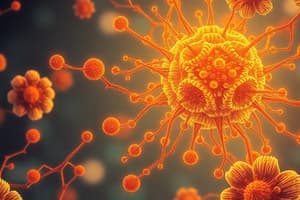Podcast
Questions and Answers
Which type of immune response is primarily mediated by T cells?
Which type of immune response is primarily mediated by T cells?
- Innate humoral immunity
- Adaptive cellular immunity (correct)
- Adaptive humoral immunity
- Innate cellular immunity
Where do T cells primarily mature?
Where do T cells primarily mature?
- Red bone marrow
- Lymph nodes
- Thymus (correct)
- Spleen
What is the primary function of T cell receptors (TCRs)?
What is the primary function of T cell receptors (TCRs)?
- To activate the complement system
- To secrete antibodies for neutralizing pathogens
- To recognize processed antigen fragments presented by MHC molecules (correct)
- To directly bind to free-floating antigens in the bloodstream
Somatic recombination in T cells is crucial for:
Somatic recombination in T cells is crucial for:
Which type of T cell primarily mediates the destruction of virus-infected cells?
Which type of T cell primarily mediates the destruction of virus-infected cells?
CD4+ T cells are also known as:
CD4+ T cells are also known as:
MHC class II molecules primarily present antigens derived from:
MHC class II molecules primarily present antigens derived from:
Regulatory T cells (Tregs) are crucial for:
Regulatory T cells (Tregs) are crucial for:
Memory T cells provide immunological memory by:
Memory T cells provide immunological memory by:
Which of the following is a professional antigen-presenting cell (APC)?
Which of the following is a professional antigen-presenting cell (APC)?
Cytotoxic T cells induce apoptosis in target cells through the release of:
Cytotoxic T cells induce apoptosis in target cells through the release of:
MHC class I molecules are found on:
MHC class I molecules are found on:
The MHC class I antigen presentation pathway primarily processes antigens from:
The MHC class I antigen presentation pathway primarily processes antigens from:
MHC class II molecules are typically loaded with peptide antigens in:
MHC class II molecules are typically loaded with peptide antigens in:
MHC polymorphism refers to:
MHC polymorphism refers to:
An individual's MHC haplotype is:
An individual's MHC haplotype is:
Co-stimulatory signals are essential for T cell activation to:
Co-stimulatory signals are essential for T cell activation to:
Abatacept, a T cell inhibitor, functions by:
Abatacept, a T cell inhibitor, functions by:
In rheumatoid arthritis, T cells contribute to the disease by:
In rheumatoid arthritis, T cells contribute to the disease by:
Ipilimumab, a monoclonal antibody used in cancer treatment, promotes T cell activation by:
Ipilimumab, a monoclonal antibody used in cancer treatment, promotes T cell activation by:
Which type of T cell is most likely to be activated against cancerous cells?
Which type of T cell is most likely to be activated against cancerous cells?
What is the role of MHC molecules in T cell activation?
What is the role of MHC molecules in T cell activation?
Helper T cells (CD4+) primarily activate which other immune cells?
Helper T cells (CD4+) primarily activate which other immune cells?
Th1 helper T cells are mainly involved in immune responses against:
Th1 helper T cells are mainly involved in immune responses against:
Which of the following is NOT a characteristic of memory T cells compared to naive T cells?
Which of the following is NOT a characteristic of memory T cells compared to naive T cells?
Which MHC class molecule is recognized by CD8 co-receptor on T cells?
Which MHC class molecule is recognized by CD8 co-receptor on T cells?
What is the primary function of granzymes released by cytotoxic T cells?
What is the primary function of granzymes released by cytotoxic T cells?
The 'peptide:MHC complex' is essential for:
The 'peptide:MHC complex' is essential for:
What is the consequence of MHC class I deficiency?
What is the consequence of MHC class I deficiency?
Which cells are targeted by cytotoxic T cells?
Which cells are targeted by cytotoxic T cells?
Flashcards
Adaptive Cellular Immunity
Adaptive Cellular Immunity
Cell-mediated immunity involving T cells destroying infected or abnormal cells.
T Cells
T Cells
A type of adaptive immune cell that matures in the thymus.
Thymus
Thymus
The location where T cells mature and differentiate.
T Cell Receptor (TCR)
T Cell Receptor (TCR)
Signup and view all the flashcards
Antigen Presenting Cells (APCs)
Antigen Presenting Cells (APCs)
Signup and view all the flashcards
TCR Recognition
TCR Recognition
Signup and view all the flashcards
Somatic Recombination
Somatic Recombination
Signup and view all the flashcards
CD4 T Cells (Helper)
CD4 T Cells (Helper)
Signup and view all the flashcards
CD8 T Cells (Cytotoxic)
CD8 T Cells (Cytotoxic)
Signup and view all the flashcards
T Regulatory Cells (Tregs)
T Regulatory Cells (Tregs)
Signup and view all the flashcards
Memory T Cells
Memory T Cells
Signup and view all the flashcards
CD4 Function
CD4 Function
Signup and view all the flashcards
Antigen Presenting Cells
Antigen Presenting Cells
Signup and view all the flashcards
CD8 T cell Function
CD8 T cell Function
Signup and view all the flashcards
Apoptosis
Apoptosis
Signup and view all the flashcards
MHC Class I
MHC Class I
Signup and view all the flashcards
MHC Class I Pathway
MHC Class I Pathway
Signup and view all the flashcards
MHC Class II
MHC Class II
Signup and view all the flashcards
MHC Polymorphism
MHC Polymorphism
Signup and view all the flashcards
MHC Haplotype
MHC Haplotype
Signup and view all the flashcards
T Cell Co-Receptors
T Cell Co-Receptors
Signup and view all the flashcards
Abatacept
Abatacept
Signup and view all the flashcards
Study Notes
- Lesson 4 is about adaptive cellular immunity involving B cells and T cells
T Cells
- T cells mature and differentiate in the thymus, originating as lymphocytes from red bone marrow.
- T cells are best suited for cell-to-cell interactions, targeting cells infected with viruses, bacteria, intracellular parasites, abnormal/cancerous cells, or infused/transplanted foreign tissue.
- T cells recognize processed antigen fragments displayed by antigen-presenting cells (APCs) via their T cell receptor (TCR).
- A T cell receptor recognizes antigen in a peptide bound to an MHC molecule.
- The T-cell receptor is a heterodimer of two transmembrane glycoprotein chains called alpha and beta chains.
- The extracellular portion of each chain has two domains resembling immunoglobulin V and C domains.
TCR Antigen Recognition
- TCRs recognize 'processed' antigen peptide fragments that are processed by antigen-presenting cells.
- Many antigens require many variable TCRs.
- TCR repertoire utilizes somatic recombination, which occurs assembling the B cell receptor and T-cell receptor genes through V(D)J recombination.
- Amino acid sequences in the antigen-binding regions of TCRs allow recognition of antigens from nearly all pathogens, including bacteria, viruses, parasites, and altered self-cells in cancer.
- Peptides that bind TCRs and activate T cells are recognized only when bound to an MHC molecule, forming a peptide:MHC complex.
T Cell-Mediated Immune Response
- T cells mediate cellular adaptive immunity, needed for intracellular antigens.
- CD4 cells (T4 cells) are primarily helper T cells called TH cells and include TH1/Th2, Th17 cells and Treg cells
- CD8 cells (T8 cells) are cytotoxic T cells (Tc) that destroy cells harboring foreign antigens.
- Memory T cells are also part of the T cell-mediated immune response.
CD4 and CD8 T Cells
- CD4 T cells carry the co-receptor protein CD4.
- CD4 T cells recognize antigens derived from intravesicular sources.
- TCR binds to MHC class II on APCs.
- CD4 T cells differentiate into CD4 T helper cells, including TH1 and TH2 effector cells that differ by the immune response type that they produce.
- Th1 cells target intracellular parasites such as bacteria and viruses.
- Th2 cells target helminths and other extracellular sources.
- CD8 T cells carry the co-receptor protein CD8 and can kill other cells, known as cytotoxic T cells.
- CD8 T cells recognize antigens derived from cytosolic sources.
- The TCR binds to MHC class I on APC/infected body cells.
- CD8 T cells cause direct cell killing by killing virus-infected and cancer cells.
T Regulatory Cells (Tregs)
- Tregs regulate or suppress other cells in the immune system to prevent excessive activation by controlling the immune response to self and foreign antigens, also helping prevent autoimmune disease.
- Natural Tregs express both the CD4 T cell co-receptor and CD25.
- CD25 is a component of the IL-2 receptor.
- TGF-beta induces differentiation of naïve CD4+ into Tregs.
- Tregs suppress activation, proliferation, and cytokine production of CD4+ and CD8+ T cells.
- Tregs help shut down immune responses after successful elimination for self-regulation.
Memory T Cells
- Memory T-cells differentiate from both CD4+ and CD8+ T-cells, remembering how to overcome invaders from defeating previous infections.
- Following infections that lymphocytes has recognised antigens, it expands to eliminate the infection and some then become long lasting memory cells.
- Memory cells respond very quickly to subsequent exposure to antigens.
T Helper Cell (CD4) Functions
- Th1 cells target intracellular parasites such as bacteria and viruses.
- The CD4 T cell binds bacterial peptide presented by MHC class II on a macrophage cells, activating the APC.
- The CD4 T cell also binds antigenic peptide presented by MHC class II displayed on a B Cell, activating the APC which is B cell.
Antigen-Presenting Cells (APCs)
- Antigen presentation is a process where protein antigens are presented to lymphocytes as short peptide fragments.
- These fragments are associated with antigen-presenting molecules, such as MHC class I or MHC class II on the surface of APCs.
- APCs are a heterogeneous group of immune cells that mediate the cellular immune response by processing and presenting antigens for recognition by T cells.
- Classical APCs include dendritic cells, macrophages, Langerhans cells, and B cells.
- APCs fall into two categories: professional and non-professional.
- Professional APCs express MHC class II, specialize in presenting antigen to T cells, and are very efficient at internalizing antigens through phagocytosis or receptor-mediated endocytosis.
- Professional APCs efficiently process antigens into peptide fragments and display those peptides bound to a class II MHC molecule Non-professional APCs express MHC class I molecules, and most nucleated cells in the body can present antigen to CD8+ cytotoxic T cells via MHC class I
Cytotoxic T Cells (CD8) Kill Virus-Infected Cells
- Cytotoxic killing occurs by releasing cytokines and cytotoxic granules.
- Cytotoxic granules are comprised of the following:
- Protein Perforin punches holes in the target-cell membrane, similar to the membrane attack complex of complement.
- Granzymes induce apoptosis.
- Fas/FasL induces apoptosis and eliminates immune effector cells during the contraction phase at the end of an immune response.
- CD8 T cells recognize and bind infected cells with antigens presented via MHC class I.
Cytotoxic CD8 T Cells Induce Apoptosis in Target Cells
- Cytotoxic T cells can recycle to kill multiple targets through serial killings.
- Each killing requires binding the T cell receptor to MHC and directed release of the following proteins:
- Perforin polymerizes to form a pore in the target membrane.
- Granzymes, which are serine proteases, get released to activate apoptosis inside the target cell by cleaving the proteins and shutting down the production of viral proteins.
Role of MHC Class I and II
- Cytotoxic T cells and regulatory T cells generally recognize target cells bearing antigens associated with MHC class I molecules.
- MHC class I molecules are found on the cell surface of all nucleated cells.
- Helper T cells recognize foreign antigens in association with MHC class II.
- MHC class II molecules are normally found only on professional antigen-presenting cells such as dendritic cells, mononuclear phagocytes, some endothelial cells, thymic epithelial cells, and B cells.
- Co-receptors CD4 and CD8 are also involved.
MHC Class I Presentation
- MHC class I molecules are found on the cell surface of all nucleated cells.
- In virus-infected cells, viral proteins are synthesized in the cytosol and peptide fragments of viral proteins are bound by MHC class I in the endoplasmic reticulum.
- Bound peptides are transported by MHC class I to the cell surface and are recognized by cytotoxic T cells and regulatory T cells bearing antigens for MHC class I molecules
MHC Class I Antigen Presentation Pathway
- Pathogen-derived proteins that are present in the cytosol of antigen presenting cells (APCs) are processed inside proteasomes.
- The processed peptides go into the endoplasmic reticulum (ER).
- Inside the ER, these peptides are loaded onto newly synthesized MHC class I molecules and transported via the Golgi to the plasma membrane to be presented to the CD8 cells.
MHC Class II Presentation
- During bacterial infections, the pathogen is usually taken up by phagocytosis in marophages to be presented to the CD 4 cells.
- In B cells, the antigen binds to the surface receptor BCR and the antigen-BCR complex gets endocytosed and is degraded to form peptide fragments.
- MHC class II molecules then binds to the degraded peptides and is transported to the cell surface for presentation to the CD 4 T cells.
MHC Class II Antigen Presentation
- MHC class II molecules bind to peptides derived from proteins degraded by proteases in the endocytic pathway.
- Peptides bind to newly synthesized MHC class II molecules in specialized antigen-processing compartments.
MHC Class I & II Polymorphism
- The function is to bind pathogen-derived peptide fragments and display them on the cell surface for recognition by T cells.
- The consequence of this is that virus-infected cells are killed directly by cytotoxic T cells, macrophages are activated to kill bacteria in intracellular vesicles, and B cells are activated to produce antibodies to eliminate/neutralize extracellular pathogens.
- MHC is polygenic, meaning several MHC class I and II genes encode MHC proteins with a range of peptide-binding specificities.
- MHC is polymorphic, meaning there are multiple alleles of each gene.
MHC Haplotype
- Each individual inherits a particular combination of MHC alleles, called a MHC haplotype.
- Each individual inherits a set of 6 genes from the mother and 6 from the father, and all genes are expressed therefore.
- There are 6 MHC class I genes and 6 MHC class II genes.
Siblings and MHC Haplotypes
- Siblings have a one in four chance that they will share the same haplotype.
T Cell Co-Receptors
- T cell activation is controlled by co-stimulatory and co-inhibitory receptors.
- In the beginning of adaptive immune response, the antigen presenting cell (APC) recognizes danger signals, such as a virus, bacteria or damaged self.
- This recognition induces the maturation of the cell, and antigen is cut into small peptides for presentation in complex with MHC.
- In addition, it leads to the induction of ligands if costimulatory molecules, such as CD80.
- All of this allows the recognition of the peptide by the TCR of the specific T cells which is then activated via costimulatory molecules (CD28).
- Activated T cells then express co-inhibitory receptors (CTLA-4, PD-1).
T Cell Inhibitor Drugs
- Abatacept is a treatment for rheumatoid arthritis blocks the co-stimulatory molecule that is necessary for T cell activation (CD28), blocking T cell activation even if MHC is presented.
- This is applied in cases of active T cells towards self antigens as a treatment to autoimmune diseases like RA.
Studying That Suits You
Use AI to generate personalized quizzes and flashcards to suit your learning preferences.




